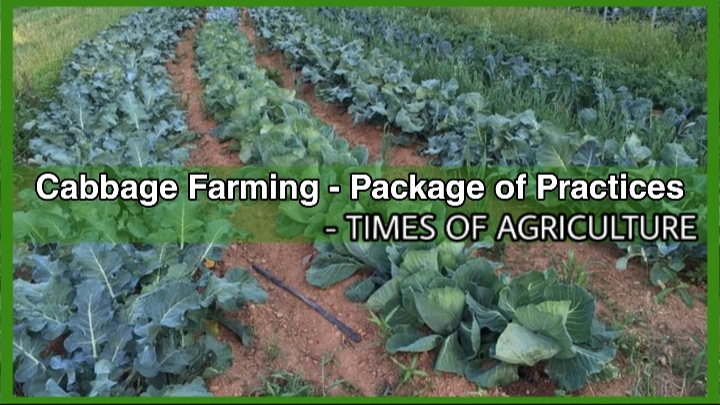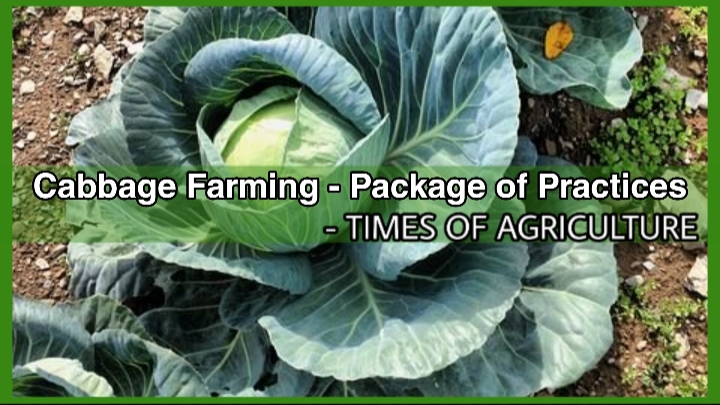How to Start Commercial Cabbage Farming – Package of Practices
In this post, we will let you know about Cabbage Farming – Package of Practices, Cabbage cultivation, pre sowing practices in Cabbage farming, post harvest management in Cabbage Farming, harvesting and yield of Cabbage Farming and other information related to Cabbage Farming in India
Crop: Cabbage
Scientific name: Brassica oleracea var. capitata
Common name/Vernacular name: Pathha Gobi
Introduction to Cabbage Farming – Package of Practices
Economic importance of Cabbage: Cabbage leaves are good sources of vitamins like A and C, and protein that has all essential amino acids. It is highly rich in minerals like potassium, magnesium, calcium, sodium, and phosphorus. It is used for the preparation of salads and sauerkraut. Cabbage highly has many medicinal properties. It is used for the treatment of cough, fever, skin diseases, ulcers, urinary discharge, and hemorrhoids. Cabbage juice has anti-bacterial and anti-cancerous properties. Anthocyanin pigments are high in Red cabbage.
List of Cabbage Hybrid varieties:
- Mita,
- Quisto,
- Bajrang (BSS-50),
- BSS-44, H-113,
- Harirani Gole,
- Pusa Mukta (SEL.8),
- Suvarna (BSS-32),
- Suhda (BSS-115).
List of Cabbage Local varieties:
- Pusa Drum Head,
- Pusa Ageti,
- MCV-1,
- Pride of India,
- Late Drumhead,
- Jersey Wakefield,
- Kranti,
- Golden Acre.
Pre sowing Package of Practices:
Soil and climatic requirement of Cabbage: It is a cool-season vegetable generally grown for its inflorescence called a head. The optimum temperature for growth is 25-35 degrees Celsius. It grows in a wide range of soils. Usually, wee-drained soils with good irrigation facilities are recommended. The optimum pH of the soil is between 6.0-6.5.
Time of sowing and seed rate for Cabbage: Sowing time differs in different regions of the country. In high hills, seeds are sown in May – June for summer crops. At North Indian Plains, sowing starts from August and continues till November. In eastern India, seeds are sown in September-October. It requires about 200-500 g for one-hectare planting.
Amaranthus Farming – Package of Practices
Nursery bed preparation of cabbage: Seeds are sown in a nursery bed and 4-6 week old seedlings are transplanted to the main field. Preparation of Raised beds of size 3 x 0.5 m and 10-15 cm height is recommended. About 70cm distance is kept between two beds for watering, weeding, etc. Well-decomposed rotten FYM @ 2-3 kg per meter is added during bed preparation. Meanwhile, seeds are treated with Trichoderma viride at the rate of 4 g or Thiram @ 3g per kg of seeds to avoid damping-off disease. Seeds are sown with a distance of 5 to 8 cm between plants at a depth of 1-2 cm covered with sand. Watering with rose can is necessary immediately after sowing.
Land preparation of Cabbage: The land is ploughed and pulverized into fine tilth and make it free and clods. Proper levelling is done and transplantation is carried out. In heavy rainfall regions, the ridge method of planting is suitable whereas for saline areas, planting in furrows and transplanting on flatbeds is suitable for dry areas. The spacing depends on different cultivars based on its maturity such as for early 45 x 45; mid 60 x 45 cm and late-maturing variety is 60 x 60 cm.
Nutrient management in Cabbage: The nutrient requirement depends upon the organic matter and fertility status of the soil. Generally, 20-25 t/ ha of well-decomposed FYM is applied at the time of the last ploughing. 180 kg of Nitrogen, 50 kg of Phosphorus, and 50 kg of Potassium are recommended. Half dose of Nitrogen, with a full dose of Phosphorus and Potassium is applied as a basal dose. Remaining half dose of Nitrogen is applied at 30-40 days of transplanting.
Water management in Cabbage: It gives maximum growth and yield when sufficient water is applied. First irrigation is given immediately after transplanting of seedlings. Subsequent irrigation is given depending upon the climatic conditions and soil properties. However, it is advised to give irrigation at 10-15 days interval. Care is taken not to have moisture stress during head formation to head maturation stage. Heavy irrigation leads to splitting of heads.

Weed management in Cabbage:
Natural weed control in Cabbage: It is necessary to keep the crop weed-free during its initial stages of growth. Two to three hand weeding at subsequent intervals based on weed intensity is necessary. Earthing up is done at one month after planting.
Chemical weed control in Cabbage: For control of weeds, pre-emergence application of fluchloralin 0.5 kg/ha or oxyfluorfen 0.2 kg/ha is recommended.
Insect Management in Cabbage:
Diamondback moth: The scientific name of Cabbage black moth is Plutella xylostella. Signs of the DBM are larvae cause mines in the leaf by scraping the epidermal tissues leading to the formation of whitish patches. Matured larvae cause holes in the head. Control the DBM in Cabbage by spraying Cartap hydrochloride 0.5% at 10, 20, 30 days in the nursery and the primordial stage. In addition, control the pest naturally by growing mustard as a trap crop in the ratio of 2:1(cabbage: mustard) to attract the adults. Crop rotation with other crops like cucumber, tomato, and chilli.
Cabbage borer: The pest is scientific name Hellula undalis. Signs of the insect pest include the immature larvae web the leaves and bore the flower and head. Chemical control by spraying Malathion 50 EC@500 ml/ha is effective. Natural/biological control of insect pest by collection and destruction of caterpillars and application of Bacillus thuringiensis @ 2g/lit per hectare at the primordial stage.
Leaf Webber of Cabbage: Signs of the insect pest Crocidolomia binotalis is the young larvae web the leaves and feed within. Spray Malathion @0.1 for effective control of the insect pest. However, control leaf webber naturally by setting up of light traps @1/ha. Removal and destruction of damaged leaves.
Cabbage butterfly (Pieris brassicae): Signs of the insect pest are the young larvae bore the head and feed within. Control the insect cabbage butterfly by spraying insecticides like quinalphos 25 EC @1lt/ha. Natural/biological control of insect pest by spraying setting up of light traps@1/ha. Removal and destruction of damaged heads.
Disease Management in Cabbage:
Blackleg disease of Cabbage: The disease is caused by fungi Phoma lingam. Symptoms of the disease are the stem of the affected plant splits vertically with severe discolouration of the black sap stream. The whole root system decays from the bottom towards up. Control the disease chemically by seed treatment with Thiram at 4 g/ kg of seed followed by Trichoderma viride at 4 g/ kg of seed. Natural/ organic control of disease: Pusa drumhead is a tolerant variety against Blackleg of Cabbage which is to be grown.
Downy mildew disease of Cabbage (Peronospora parasitica): Symptoms of the disease are purplish leaf spots on the upper surface of the leaf with fluffy downy fungus growth on the lower surface. Chemical control the disease by foliar application of Metalaxyl @ 0.4% per hectare is recommended. However, avoiding splash irrigation to the crops. Avoid mechanical damage to crops also controls the disease to an extent.
Clubroot disease of Cabbage caused by Plasmodiophora brassicae. Symptoms are swelling and clubbing of roots with stunting and yellowing of plants. Control by seed treatment with Thiram at 4 g/ kg of seed followed by Trichoderma viride at 4 g/ kg of seed. Soil drenching with copper oxychloride @ 0.25 % is also recommended. Mechanical control by maintaining proper drainage facilities in the field.
Potato Farming – Package of Practices
Black rot of Cabbage:The disease is caused by Xanthomonas campestris pv. Campestris. It leads to yellow ‘V’ shaped spots along the leaf margins with a typical black discolouration of the veins. In severe infection, the vascular bundles turn black. Chemical control by applying bleaching powder at 10.0 to 12.5 kg/ha is advisable.
Maturity indices of Cabbage: It is generally based on head size.Heading-type cabbage is harvested as small as 10 cm in diameter and is continued until 15 cm to 25 cm depending upon the variety.
Harvesting and Yield in Cabbage Farming – Package of Practices
Harvesting of Cabbage: It is carried at the right stage to get a good qualityhead.It is done by bending the head and cutting with a sharp knife. The early maturing varieties take 60-80 days, medium 80-100 days and late-maturing varieties take 100-130 days for harvesting after transplanting.
Yield of Cabbage: Yield varies about 400-500 quintals per hectare depending upon variety and climatic conditions.
Post-harvest management of Cabbage: Harvested heads are kept in a mulberry basket or wooden boxes and sent for distant markets.
Economics of Cabbage: To cultivate Cabbage in one acre, it costs around Rs.29, 000 / ac. However, the farmer can get an income of Rs.1, 40,000 / ha by selling the yield. Therefore, the farmer can get a profit of Rs.1, 11, 000/ac
Summary of Cabbage farming: It is a highly profitable crop with high net returns.

I would like more information about the farming it’s my next frontier.